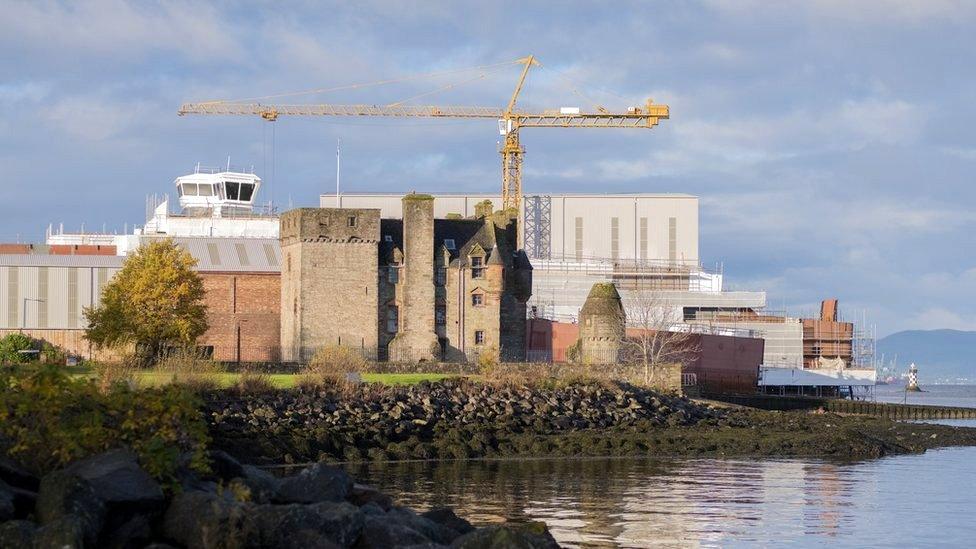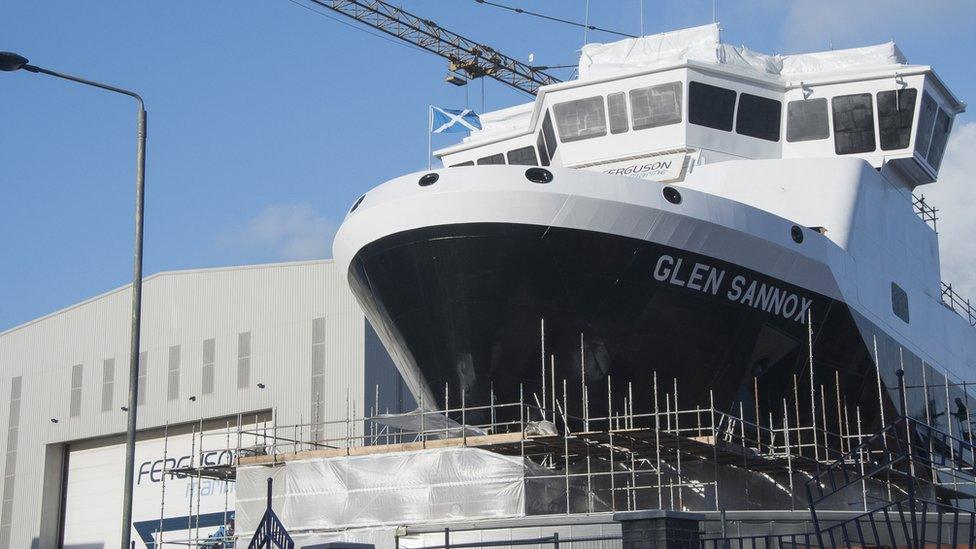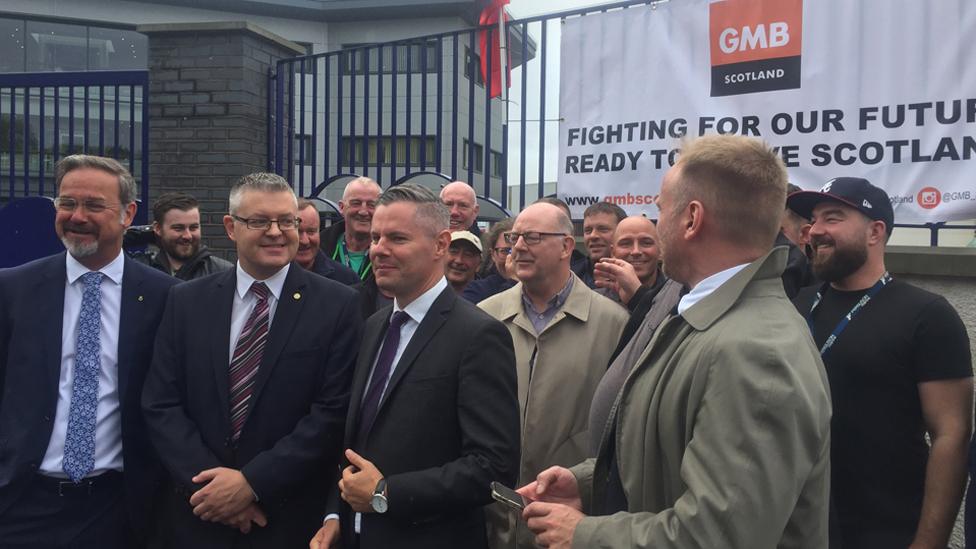Shipyard forecast: Sunshine becoming misty
- Published

Ferguson shipyard was nationalised on Friday
Ferguson Marine's administration is not complete, but nationalisation is assured
In public ownership, the plan, for now, seems very limited - to completing two CalMac ferries
The next phase requires a commitment to more west coast ferries, and to private sector contracts. The Type 31e frigate order could make the Ministry of Defence one of Ferguson's biggest clients
Unions want to see a long-term commitment to keep up the drumbeat of orders and a bigger picture of state intervention in the economy. Instead, economy secretary Derek Mackay may choose to sell on his new shipyard
The words "back to work on Monday" cause weariness for many. For 300 workers at the Ferguson shipyard this weekend, they are a big relief.
The reassurance that jobs are safe follows months of growing uncertainty and more than two years of dispute over the contract for CalMac ferries that sank the previous owner's corporate vessel.
Jim McColl was "bitterly disappointed" at the out-turn of events for his five-year ownership the yard.
That was having been hailed as a hero when he bought it out of administration, and having been widely admired by the workers for what he was trying to do.
He departs claiming to be £28.5m worse off - much of that sunk in the cost of modernising the yard.

An order for CalMac ferries has been at the centre of a dispute
It's less clear what Derek Mackay, the finance and economy secretary, plans to do as the new ultimate boss of the yard.
But he's made a start by reassuring that workforce about their jobs, and emphasising to the people of Arran, Harris and North Uist that their long overdue replacement ferries will, eventually be completed.
That may, or should, become clearer as the dust settles on the administration process, and as the new team get to work.
The new team consists of a "turnaround manager" and the review board - representing various quangos, plus union convener Alex Logan - which is newly set up.
Here are some of the issues they face, and a recap. First...
Why nationalisation?
Not ideology, Derek Mackay told me on Friday.
"We really don't want to own a shipyard," adds one of his team.
It's financially very risky, but also hard to avoid. If the Scottish government was not going to help Jim McColl's company pay for the roughly £97m overspend on the £97m fixed price contract (and they claim it would have been unlawful to do so), and if Mr McColl was not going to dig deeper for it, then the company was bound to go bust.
And so it did. To leave it at that, which is the usual role of government when factories close, would be to walk away from a company which had a £45m outstanding loan from the Scottish government.
And nearly £97m has already been paid towards the price of those two unfinished ships (why so much when the ferries were far from complete? MSPs will want to know). Put the two figures together - £142m - and almost all of that money would be lost.
The name's 'bond'
Some could have been recouped as a creditor. But the catch is that the finance firm HCCI had issued a £25m bond as surety for the CalMac order. That bond made it primary creditor in the event of administration.
HCCI could have taken over the yard and held it hostage, laying off the staff and selling anything with a market value.
HCCI has agreed not to do that, but at a price. I'm told the Scottish government has yet to negotiate the share of that £25m that it would cost HCCI to drop its prior claim on the asset.

Jim McColl was "bitterly disappointed" at the out-turn of events for his five-year ownership the yard
The sum should be somewhere between, roughly, the amount that HCCI could have raised if it took over the yard, and, also roughly, the value to the Scottish government of being able to get its hands on the yard and those ships.
If they cannot finalise that figure, then the nationalisation plan is off.
That's because this remains a process. The administrator Deloitte - chosen by HCCI, being the creditor that launched the administration court action - has yet to market the yard to potential alternative buyers.
There won't be a queue. Any other bidder - apart from taking on a yard that has twice been in administration in five years - has to get past not only HCCI but also the secondary creditor, which is the Scottish government. It would seek a large chunk of its loan back, and its unfinished ferries as well.
The pretence of a marketing process will last up to four weeks, and then the Scottish government moves from management contract, on behalf of the administrator, to being outright owner.
In the face-off with Jim McColl, it won. But by winning, it has a very expensive project to finish, and a future path to set.
What then?
The horizons set by Derek Mackay are to finish the Glen Sannox, lying alongside the Port Glasgow quay, and hull number 802 - barely shipshape, so far unnamed and gently corroding on the slipway.
The union view, which seems to be shared with the Scottish government, is that there should be no requirement for the Scottish government's procurement agency to put its ferry orders out to tender. It can simply place the orders with the state-owned shipyard.
That should be a comfort, if the long-term future of Ferguson is to be the builder of CalMac ferries. It's less of a comfort to the taxpayer if cost controls don't improve a lot. Without competitive pressures, why should they?

Finance Secretary Derek Mackay visited the Port Glasgow yard on Friday
It will require more work if it is to sustain current workforce numbers.
There's a hovercraft barge under construction alongside hull 802, destined for the central Asian oil industry. If that pioneering technology lives up to expectations, there could be more such orders, for lifting big bits of industrial kit over ice and difficult terrain.
The fish farming industry is keeping some of the workforce busy, with supply vessels. And if, as it wants, aquaculture is going further offshore, it will need more and bigger boats to get there.
It's unclear if Ferguson will retain a part in a consortium of companies developing hydrogen-powered ferries, for use initially in Orkney.
It's unclear if it can finalise a deal Jim McColl's team claim to have had nearly in the bag, to build offshore patrol vessels for Bangladesh, funded by the British government's aid budget.
Frigates
And there's the Type 31e - the next generation light frigate for the Royal Navy and intended also for export orders, to be built by one of two consortiums.
The group in which Ferguson is fighting includes Babcock, with its base at Rosyth and Harland & Wolff in Belfast, which recently went into administration, and where there is a high-profile worker sit-in.
BAE Systems, with limited capacity in its Clyde yards while it is building the Type 26 frigate, is in the other consortium, providing the design expertise for Cammell Laird to build the ships at its Merseyside shipyard.
The word is that an announcement on a preferred bidder for that contract is imminent, and that it's looking good for the Babcock-led group.
That could raise the question of whether Ferguson and Harland & Wolff can emerge from administration to take on such work. Looked at another way, it could be a rabbit out the Ministry of Defence hat with which Boris Johnson's new Whitehall administration can champion shipyards in Scotland and Northern Ireland.
Where does Ferguson fit?
Among trade unionists, the GMB and Unite are relieved and a little apprehensive about nationalisation. They're seeking a 20-year commitment to maintain the drumbeat of CalMac ferries. They're not getting one, yet.
The apprehension is because a big ship can only sustain about 150 jobs, while smaller ships would require less. The current workforce is 300, so more than CalMac will be required to secure Ferguson's future at a commercially-competitive scale.
Meanwhile the STUC is asking where this fits in to the SNP government's broader economic strategy.
The umbrella body's Dave Moxham was on the BBC airwaves, echoing some of the economic thinking that holds sway in the first minister's office. That's about governments using their procurement clout to shape big strategic projects, including reduction of climate changing emissions and, in Scotland's case, an integrated public transport system.
Asked about this on Friday, Derek Mackay wasn't rising to the strategic vision - not yet anyway. He wanted only to emphasise the fact that jobs were protected, the ferries would be finished, and the shipyard has a future.
What sort of future? A different type of enterprise, showing what the state can do with the levers of corporate power? Or a future of being passed back to the private sector?
I got the sense that the plan is closer to the latter - getting the two unfinished ferries completed, and then looking to sell. Either in the next four weeks or the longer term, he welcomes interest from investors.
But don't expect Jim McColl to give it another try.
- Published18 August 2019

- Published16 August 2019

- Published9 August 2019

